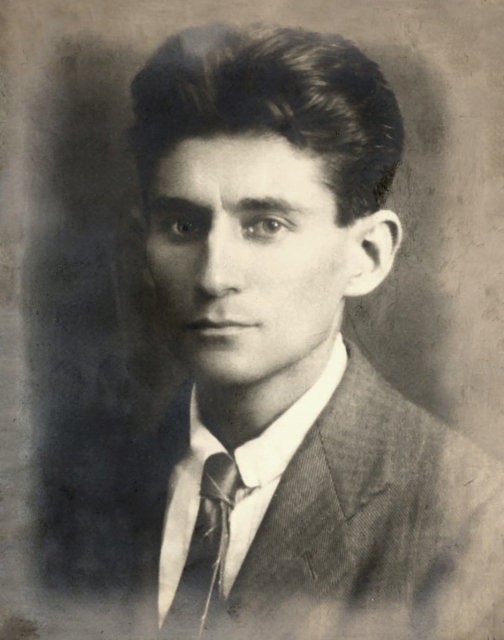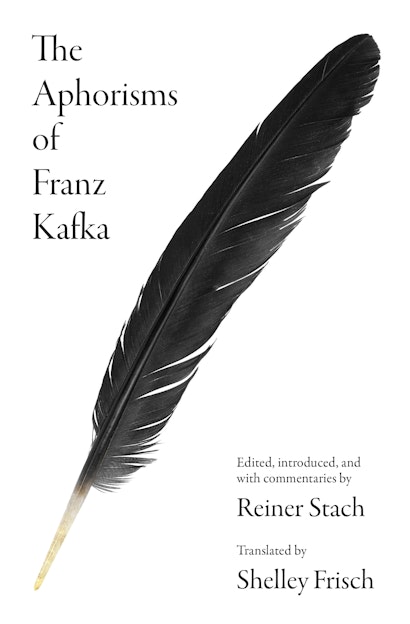As Princeton University Press celebrates the launch of a new annotated and freshly translated edition of Kafka’s aphorisms, the Press has invited me to supply a couple of amuse-bouches from the two introductory passages to the collection, namely my Translator’s Note plus a brief excerpt from Reiner Stach’s Foreword. I am delighted to oblige, and I hope you will be tempted to savor the main course of The Aphorisms of Franz Kafka.
—Shelley Frisch
Translator’s Note
After translating Reiner Stach’s magnificent three-volume Kafka biography—published by Princeton University Press—I have now had the pleasure of returning to Franz Kafka, to Reiner Stach, and to the Press to work on this new annotated edition of Kafka’s aphorisms. Translating this slim but seminal volume has deepened my understanding of all of Kafka’s writings, even after the extremely deep dive I did for the biography.
The Aphorisms of Franz Kafka is not the first translation into English of Kafka’s “Zürau aphorisms,” but this new edition differs from all older ones in two notable respects. First and foremost, Reiner Stach’s meticulous and astute interpretive guidance, which follows the translation of each aphorism, situates the individual aphorisms within the larger context of Kafka’s writings and in doing so sheds light on both the elusive aphorisms themselves and the entirety of Kafka’s writings. My challenge here was to pick up on the nexus of interconnections that Reiner Stach laid out in his commentaries and take a fresh approach to the translations of the aphorisms with these interconnections in mind. The German word Weg, for example, traces a path throughout the aphorisms and is a significant connecting thread, which unspools when the word—which can mean way, route, road, etc.—is rendered in a variety of ways, as it has been in previous translations. My translation, which uses path throughout, underscores the linkages between the aphorisms. As Andrew Hui points out in A Theory of the Aphorism: From Confucius to Twitter, “aphoristic writing can become a recursive exercise of saying the same thing in many different ways. Its concision invites repetitions and modulations. But this repetition is never sterile… it functions as an intensification of the problems at hand, affording discovery and experimentation.”[1]
We learn from Stach’s commentary that Einpfählen, in Aphorism 2, is a word that Kafka presumably knew from horticulture, and “refers to the use of posts to prop up and stabilize young fruit trees with (usually three) posts or to the use of fence posts to enclose a pasture. Kafka had ample opportunity to observe this work in Zürau.” Hence, it is more specific in its origins and imagery than the pinning down one might find in other renderings of this aphorism. Stach’s details about the dating and updating of the aphorisms clue us in to the evolution of Kafka’s thought and what he was reacting to at the time of their composition. An aphorism such as number 93 (“Psychology, for the last time!”)—which scarcely fits the category of “aphorism” at all—cries out for context, and here, again, the annotations connect this potentially baffling outburst to Kafka’s readings at the time, his correspondence, and his overall outlook on psychology. And by learning the details of Kafka’s revisions, we gain deeper insight into Kafka’s conceptual grapplings, such his choice of “invalid” (nichtig) after trying out and rejecting “incorrect,” then “false,” for Aphorism 6.
A second feature of this new edition is its inclusion of Kafka’s original German for each of the aphorisms, thus furnishing readers who know German with still more interpretive tools. Kafka’s aphorisms can be so cryptic that the discerning reader stands to benefit from every possible route of entry to them. In this bilingual edition, word usages and repetitions can be tracked in both languages. The inclusion of the original German wording serves to highlight where Kafka was tugging at the borders of “proper” German (Alle menschlichen Fehler sind Ungeduld: “All human errors are impatience”), and has allowed my translations of the aphorisms to adhere more closely to Kafka’s wording without seeming off—or more off, at any rate—than they appeared in German.
We have come a long way from Max Brod’s original packaging of the aphorisms under the title “Reflections on Sin, Suffering, Hope, and the True Way,” which nudged Kafka’s words in the theological direction Brod hoped to take them. We can now grasp anew the meaning of these enigmatic aphorisms—which many readers of Kafka consider the core, and jewel, of his oeuvre as a whole—while enhancing our understanding Kafka’s letters, diaries, short prose, and novels. I hope and trust that readers of this richly annotated volume will enjoy poring over it as much as I have enjoyed translating Franz Kafka’s aphorisms and Reiner Stach’s eye-opening commentaries.
Excerpt from Reiner Stach’s “Foreword”
Kafka knew that there are no absolute beginnings; rarely has an author captured, in such compelling images, the exhilarating yet appalling fact that no past is ever past. That is why the fresh start he longed for could not mean simply brushing aside his achievements over the previous year. Even in his Country Doctor stories, which he was still eager to see in book form as soon as possible (Wolff did not actually publish the volume until the spring of 1920, which so infuriated Kafka that he thought of switching publishers), it was clear that his pleasure in spinning yarns, in recounting, had been cast aside in favor of contemplation and strict succinctness. Even though he eventually acquiesced to the subtitle “Short Prose,” Kafka was experimenting with the forms of parable and legend in this volume, and even the “Report to an Academy,” which abounded in grotesque and sensory details, was more a self-critical report than a narrative. Then there was “Eleven Sons,” which dispensed with plot altogether and consisted solely of monological assessments. This was no longer the “portrayal of my dreamlike inner life” that Kafka had insisted was his sole interest just three years earlier; this was an entirely different scheme. “I can still have passing satisfaction from works like A Country Doctor,” he noted in Zürau, “provided I can still achieve something of the sort (highly improbable), but happiness only if I can raise the world into the pure, the true, and the immutable.”
If A Country Doctor had been published back in the fall of 1917, any knowledgeable reader would have noticed that this author had not only shifted gears, but had embarked on a totally new path. His friends Max Brod, Felix Weltsch, and Oskar Baum were well aware of this change. They knew Kafka’s latest texts from his occasional private readings and hoped that in Zürau he would reap a comparable harvest. Hadn’t Kafka always complained that as long as he was hemmed in between the hours he spent at the office and his family obligations, he lacked the requisite freedom? “Having been dependent on others for the most part,” he wrote a year before Zürau, “I have an infinite longing for self-reliance, independence, freedom in all directions …” No sooner had he arrived in the village than he wrote a letter praising “freedom, freedom above all.”
So what did Kafka do with this newfound freedom? He planted vegetables, dug potatoes out of the ground, pitched in here and there when the hops were harvested, and assisted in mating the goats. Between these activities he passed many hours lying in a lounge chair and reading in the blazing sun, then wrapped himself in blankets. In the evenings he composed witty, almost boisterous letters depicting the ascetic village life and a few tentative social contacts he had made, and spent quite a few pages describing the legions of mice that plagued him at night in his room. As entertaining as this writing was, these were not the stories that people back in Prague were hoping for from him. Now that he had a potentially deadly disease in his body, Kafka spoke and lived as though he had an infinite amount of time at his disposal.
But in reality, Kafka led a double, and even a triple, life in Zürau, which no one besides him could get a full picture of while he was there, but which can now be reconstructed from the written records. In the view of the villagers, Kafka was the “Herr Doktor” from Prague, unfailingly friendly and cooperative, though not very talkative and therefore hard to read, and not in the best of health, as they could tell not from his appearance, but from his shortness of breath. In the view of his friends in Prague, he was now the author of some comic mouse letters, who on occasion also wrote about the books he was reading and provided lengthy yet cryptic remarks about his tuberculosis. These letters alarmed their recipients, as the patient seemed to be spending far more time and energy on interpreting his illness than on recovering from it.
And then there was a third, hidden dimension of his life in Zürau, the significance of which not even his sister may have been aware. Two nondescript octavo notebooks, about 16.5 by 10 centimeters, with penciled scribblings that extended into the margins, generally in the slapdash penmanship that revealed he was writing in a lounge chair, his texts riddled with horizontal lines, shorthand symbols, and countless revisions. Occasionally there was a date, a comment about a long walk, or some brief stabs at narratives, but his entries most often consisted of reflective prose that abounded in startling images and metaphysical speculations.
This, then, was the “beginning” that Kafka had prescribed for himself—the continuation of a movement toward abstraction, as was already evident in the stories in A Country Doctor (we even find conceptual and visual foreshadowings of the aphorisms in that volume), but now he did so with the utmost determination, crossing the boundaries of literature and heading up to the pinnacles that defined western metaphysics as he engaged in speculations about “evil,” “truth,” “belief,” and the “world of the spirit.” Kafka’s notes invoked an awe-inspiring term for these topics, calling them “the ultimate things,” and he had no qualms about claiming a little pathos for himself in this sphere as well. “What I have to do, I can do only alone,” he assured Brod during a visit in Prague in late December, “gain clarity about the ultimate things.” That sounded as though Kafka was intent on justifying his painful, yet merciless parting from Felice Bauer—which had just occurred—and his undertaking sounded like a new endeavor that would brook no compromises. He was actually talking about a project that had been underway for months, the initial product of which was concealed in two nondescript little notebooks.
Reiner Stach is the author of the definitive three-volume biography of Franz Kafka: Kafka: The Early Years; Kafka: The Decisive Years; and Kafka: The Years of Insight (all Princeton). He is also the author of Is That Kafka? 99 Finds. Shelley Frisch is an award-winning translator whose work includes Stach’s Kafka biography, Karin Wieland’s Dietrich & Riefenstahl, and Billy Wilder on Assignment (Princeton), among many other books.
Notes
[1] Andrew Hui, A Theory of the Aphorism: From Confucius to Twitter (Princeton University Press, 2020), p. 20. Hui also notes the experience readers have come to associate with reading aphoristic writings, “The irony is that the aphorism—this shortest of forms to read—actually takes the longest time to understand.” (p. 6)

